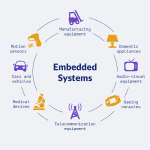Table of Contents
In the simplest terms, cloud computing is the delivery of computing services over the Internet (“the cloud”). These services include servers, storage, databases, networking, software, analytics, and intelligence to offer faster innovation, flexible resources, and economies of scale. You typically pay only for cloud services you use, helping you lower your operating costs, run your infrastructure more efficiently, and scale as your business needs change.
Rather than keeping files on a proprietary hard drive or local storage device, cloud-based storage makes it possible to save them to a remote database. As long as an electronic device has access to the web, it has access to the data and the software programs to run it.
Cloud computing is a popular option for people and businesses for a number of reasons including cost savings, increased productivity, speed and efficiency, performance, and security.
Life before cloud computing
Traditional business applications have always been very complicated and expensive. The amount and variety of hardware and software required to run them are daunting. You need a whole team of experts to install, configure, test, run, secure, and update them.
When you multiply this effort across dozens or hundreds of apps, it’s easy to see why the biggest companies with the best IT departments aren’t getting the apps they need. Small and midsize businesses don’t stand a chance.
Cloud computing: a better way
With cloud computing, you eliminate those headaches that come with storing your own data, because you’re not managing hardware and software — that becomes the responsibility of an experienced vendor like AWS or Azure. The shared infrastructure means it works like a utility: You only pay for what you need, upgrades are automatic, and scaling up or down is easy.
Cloud-based apps can be up and running in days or weeks, and they cost less. With a cloud app, you just open a browser, log in, customize the app, and start using it.
As cloud computing grows in popularity, thousands of companies are simply rebranding their non-cloud products and services as “cloud computing.” Always dig deeper when evaluating cloud offerings and keep in mind that if you have to buy and manage hardware and software, what you’re looking at isn’t really cloud computing but a false cloud.
Cloud computing can be both public and private. Public cloud services provide their services over the Internet for a fee. Private cloud services, on the other hand, only provide services to a certain number of people. These services are a system of networks that supply hosted services. There is also a hybrid option, which combines elements of both the public and private services. More information is outlined below.
Regardless of the kind of service, cloud computing services provide users with a series of functions including:
- Storage, backup, and data retrieval
- Creating and testing apps
- Analyzing data
- Audio and video streaming
- Delivering software on demand
Top benefits of cloud computing
Cloud computing is a big shift from the traditional way businesses think about IT resources. Here are seven common reasons organizations are turning to cloud computing services:
Cost
Cloud computing eliminates the capital expense of buying hardware and software and setting up and running on-site datacenters—the racks of servers, the round-the-clock electricity for power and cooling, and the IT experts for managing the infrastructure. It adds up fast.
Speed
Most cloud computing services are provided self service and on demand, so even vast amounts of computing resources can be provisioned in minutes, typically with just a few mouse clicks, giving businesses a lot of flexibility and taking the pressure off capacity planning.
Global scale
The benefits of cloud computing services include the ability to scale elastically. In cloud speak, that means delivering the right amount of IT resources—for example, more or less computing power, storage, bandwidth—right when they’re needed, and from the right geographic location.
Productivity
On-site data centers typically require a lot of “racking and stacking”—hardware set up, software patching and other time-consuming IT management chores. Cloud computing removes the need for many of these tasks, so IT teams can spend time on achieving more important business goals.
Performance
The biggest cloud computing services run on a worldwide network of secure data centers, which are regularly upgraded to the latest generation of fast and efficient computing hardware. This offers several benefits over a single corporate data center, including reduced network latency for applications and greater economies of scale.
Reliability
Cloud computing makes data backup, disaster recovery and business continuity easier and less expensive because data can be mirrored at multiple redundant sites on the cloud provider’s network.
Security
Many cloud providers offer a broad set of policies, technologies and controls that strengthen your security posture overall, helping protect your data, apps and infrastructure from potential threats.
Agility
The cloud allows you to innovate faster because you can focus your valuable IT resources on developing applications that differentiate your business and transform customer experiences rather than managing infrastructure and data centers.
With cloud, you can quickly spin up resources as you need them, deploying hundreds or even thousands of servers in minutes. The cloud also makes it easy and fast to access a broad range technology such as compute, storage, databases, analytics, machine learning, and many other services on an as-needed basis.
As a result, you can very quickly develop and roll out new applications, and your teams can experiment and innovate more quickly and frequently. If an experiment fails, you can always de-provision resources without risk.
Deploy globally in minutes
With the cloud, you can easily deploy your application in multiple physical locations around the world with just a few clicks. This means you can provide a lower latency and better experience for your customers simply and at minimal cost.
Elasticity
Before cloud computing, you had to over-provision infrastructure to ensure you had enough capacity to handle your business operations at the peak level of activity. Now, you can provision the amount of resources that you actually need, knowing you can instantly scale up or down with the needs of your business. This reduces costs and improves your ability to meet your users’ demands.
Cost savings
The cloud allows you to trade capital expense (data centers, physical servers, etc.) for variable expense and only pay for IT as you consume it. Plus, the variable expense is much lower than what you can do for yourself because of the larger economies of scale.
Some Major names in Cloud Computing
Read on – Read the beginners guide to cloud services to understand various terms like Iaas, PaaS, SaaS and Serverless, their applications and advantages.
Hi, I’m Vivek, a Senior Embedded Innovation Specialist. I have been working on Embedded Systems and IoT for the past 11 years. I love to share my knowledge and train those who are interested. Nerdyelectronics.com was started out of this interest. You can read my full profile in this link.







